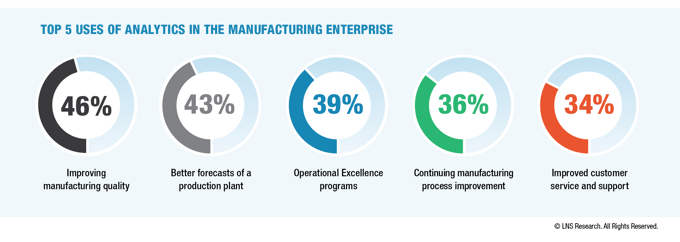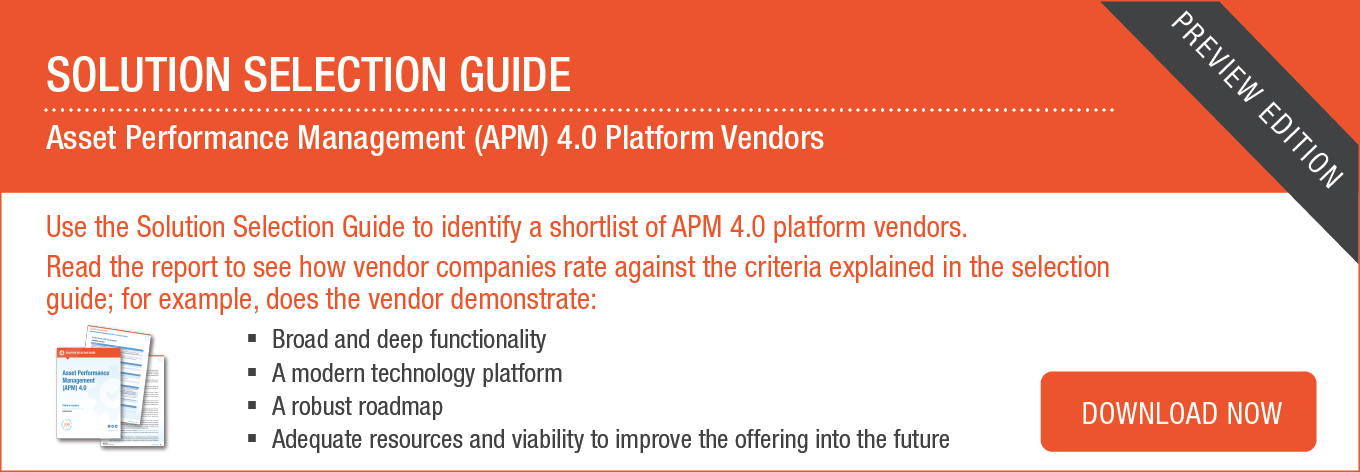Every year LNS Research puts forth predictions around the key trends in the Industrial Transformation topics where we focus our work. In the case of asset performance management (APM), my 2018 forecast focused on the evolution of APM 4.0. I predicted that in 2018, the most significant shift in APM would be the move away from the maintenance-centric approach that APM was born from 15-20 years ago. That shift would include enterprise asset management (EAM), computerized maintenance management systems (CMMS) and a focus on reliability and downtime reduction. The result would be an emphasis on Digital Twins and showing that prescriptive analytics is more about asset optimization than just reliability and availability. The specific APM predictions were:
Click here to speak with Dan Miklovic.
- Artificial intelligence (AI) and machine learning (ML) get applied to operational performance;
- Digital Twins incorporate more “what-if” capabilities;
- Autonomy starts to show up on the shop floor in maintenance; and
- Mergers and acquisitions (M&A) in APM intensifies while new entrants continue to enter the market.
With Joe Perino joining LNS to head up our 2019 APM and process manufacturing and infrastructure research, I asked him to lead our assessment of this year’s predictions. This is his view of how well we stacked up against what really happened in 2018.
Focus on the Business
This shift indeed started to occur with several vendors elaborating a broader message to incorporate the benefits of higher productivity, reduced risk, and increased profitability as a result of a more holistic approach to APM. Notable examples include ABB in power generation, Schneider Electric with EcoStruxure, Emerson’s Top Quartile, Honeywell with Connected Plant, AVEVA with their full lifecycle APM, Bentley with AssetWise, and DNV-GL with APM. However, APM messaging is not always front and center, since some vendors require one to sift through their products and solutions to find it. We give ourselves a solid “B” for this prediction since the messaging evolution was on-target, but the timing and consistency across the vendor landscape varied depending on which direction any specific vendor approaches APM.
Growth in Digital Twins
In 2018 we expected the Digital Twin to include physical aspects of the twin as well as the process aspects. This is happening at two levels, in the design and engineering space, and in the operations space, with so far only a few vendors looking to offer a full cycle solution. Most vendors have added the number and types of equipment they can monitor using AI techniques and Digital Twins, and some have incorporated the process along with the equipment to create “unit-wide” digital twins. AVEVA bringing SimSCI, legacy software and PRiSM/Avantis together and Aspen bringing Simulation, Modeling, Fidelis and Mtell together are good examples of those vendors making the connection.
We are just beginning to see offerings move from predictive to prescriptive and “what if” scenario capabilities. Functionalities that have been in discrete manufacturing’s operations, supply chain, and sales and operations planning (S&OP) for some time, have yet to migrate to the process side. The growth in overall analytics has been mainly on the operations side.

Furthermore, it’s interesting to note who isn’t offering Digital Twin that one would think should be … process licensors and manufacturing equipment suppliers. We should note that there is still a lack of general industry understanding of what constitutes a Digital Twin. Overall, we give ourselves a “C” on this prediction since things are moving, but not as fast and far as we expected.
Autonomous Devices, Uneven Adoption
For 2018, we viewed autonomous operation as still an aspirational goal. We said we would see more robots and other process systems behaving autonomously, but the application of such technologies has been limited to smart tooling and robotics in warehousing, retail (Amazon’s automated warehouses quickly comes to mind), and discrete manufacturing.
In the process industries, drones are being widely used for inspection, e.g. leaks and spills, but are not yet autonomous, and in many cases are not entirely effective because detailed inspection requires removal of insulation and coatings. Mining is still likely the most advanced sector in the space. We have yet to see process plants retrofitted or newly designed with autonomous vehicles to deliver spare parts, carry tools, maintenance equipment, and personnel to a process unit.
Again, we give ourselves a “C” on this prediction; things are moving, but we haven’t seen the significant experimentation in most forms of manufacturing that we expected.
Evolving Vendor Landscape
Our last category is the evolving vendor landscape; we give ourselves a spot-on “A” here. M&A, consolidation, and startup activity is everywhere with the major vendors in high gear to fill the gaps in their solution offerings, where much of this will be done through acquisition and partnerships instead of organic development. The markets are simply moving too fast for most companies to rely on their internal R&D to keep up.
Examples include the major deal between Schneider and AVEVA, KBC Advanced Technologies with six different partnerships in 2018, most notably with GE_BakerHughes for their APM suite, Siemens’ increasing investment in their Bentley partnership, Uptake’s acquisition of AP, TrendMiner picked up by Software AG, UTC adding Predikto, IBM’s purchase of Oniqua, and Accruent’s acquisition of Maintenance Connection.
We see this trend continuing as the market dynamics are moving so quickly.
Joe Perino will take the lead on the APM 2019 predictions, so stay tuned ― this next year is sure to be even more interesting.
